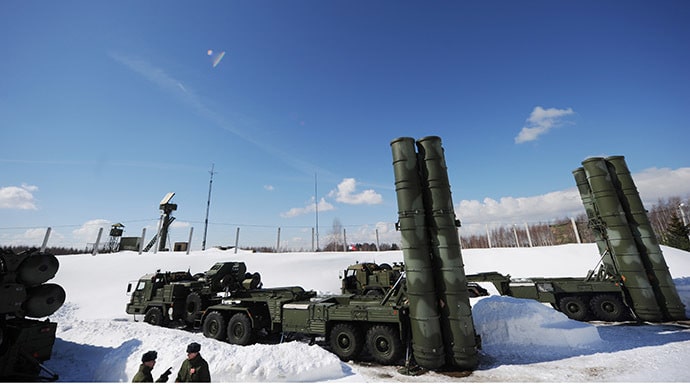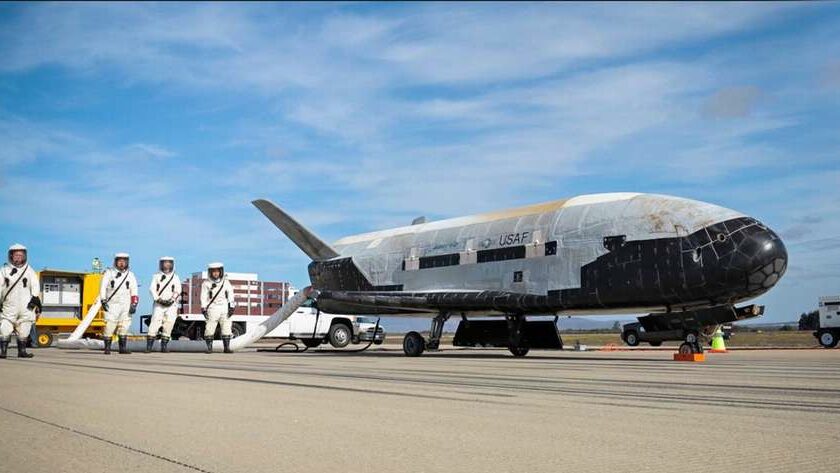The X37b drone: luxury gadget or future Swiss army knife essential for conducting operations in a non-permissive environment?
The last two weeks have brought their share of new products with the X37B, the American space drone. Presented in turn as an “automatic” shuttle or a “pseudo-satellite”, these terms reflect a certain doctrinal vagueness around this platform which could become an intermediate operational brick between “large drones” and satellites.
We remember the debate led a few years ago concerning the comparative advantages between strategic drones (HALE and MALE[efn_note]Medium/High Altitude Long Endurance [/efn_note]) and satellites, particularly in ISR missions. If the debate was essentially rhetorical, it highlighted the complementarity of the latter. Satellites allowed freedom from legal overflight constraints, almost total security in the face of anti-aircraft defenses despite a certain transience in terms of revisits to the theaters. For their part, the drones provided increased optical resolution and electronic warfare capabilities – due to their greater proximity to the ground – and greater permanence due to endurance[efn_note]More than 24 hours for MALE drones of type MQ9 Reaper and 36 hours for HALE drones type MQ4 Global Hawk. [/efn_note] of their orbits[efn_note]Permanent Multi-Sensor Armed Surveillance Orbits (OPASM): allows for permanence in an area or theater via “constellations” of drones taking turns taking turns. [/efn_note]. Furthermore, the drones were able to carry more sensors and overcome the weather constraints which could prove incapacitating for a ROIM satellite (e.g.: cloud cover above a theater of operation).

Ce system of systems, relatively well locked and fluid in the context of an asymmetrical or conventional conflict of low intensity (semi-permissive theater) could however well become insufficient. Indeed, “Western” armies have based their superiority for 30 years as much on information-enhancement as on “network-centric” whose architectures are largely based on the 3rd and 4th dimensions. The “pair” of satellites and strategic drones form the keystone but also the backbone of our C4ISTAR systems[efn_note]Command, Control, Communication, Computer, Intelligence, Surveillance, Targeting, Asses, Reconnaissance [/efn_note]. However, the rapid emergence, in number and quality, of new technological players, potentially warlike, calls into question this military domination. In 20 years, Russia and China, and consequently their partners, have designed their military tools by focusing on contesting these main Western assets, the latter also constituting their main weakness.
A contested and potentially prohibited aerospace environment?
The new threats facing Western armies can be roughly grouped under the terminology A2AD (Anti-Access/Aerial Denial), directly affecting the in-flight resilience of strategic drones and satellites in orbit. The Russian and Chinese armies do not (yet) have force and power projection capabilities commensurate with Western means, but are in a position to deny access to an expeditionary force in a theater of operation. They are then given increasing political freedom due to the neutralization of means classics of coercion.
This denial of access involves in particular a strengthening of multi-layered anti-aircraft capabilities[efn_note]A set of detection and interception systems combining electronic warfare and kinetic capabilities. These systems intersect within a bubble combining, broadly speaking, long, medium and short and very short range systems [/efn_note]. Among these defenses, we find the S-400 system capable of intercepting a 400 km vector and up to an altitude of more than 50 kilometers or, by 2030, the S-500 (500-600 km, altitude 180 km and more) . Or MQ-9 type vectors Reaper and MQ-4 Global Hawk peak at 16 and 000 m respectively and are not stealthy.

This type of system, combined with capacities of offensive jamming very advanced, particularly within the Russian army, also tends to proliferate towards more and more numerous actors presenting, to varying degrees, threats to Western countries: China, Iran, Turkey, Pakistan, etc. ... These fears are also confirmed by current events, with Iran having claimed destruction of two MQ4s in June and most recently on November 08, 2019. Let us clarify that the MQ-4 is not a “consumable” machine but a high-value platform that only the American BITD is able to produce. It is certainly not a question of limiting oneself to a simple superposition of ranges and altitudes which would not take into account the complexity of a theater of operation, but rather of asserting the increasing vulnerability of aerial vectors exposed today to strong contestation in the 3rd dimension. A challenge to which Westerners had been incompletely confronted, and prepared, for 30 years.
Regarding the spatial component, the threat is different and more unprecedented. Indeed, if Westerners have not been confronted for several decades with the need to achieve air superiority, they had never been confronted with a protest in the 4th dimension. This dispute, which is eminently strategic in nature, is historic in the full sense of the term because it is largely the work of a non-Western power, China, an event unprecedented for 5 centuries. The speed and intellectual vigor of its rearmament are impressive, as evidenced today by the organization of the new Strategic Support Force (FSS).

It is the Chinese “space army” which brings together all communications, intelligence (ROIM and ROEM), geo-positioning, tracking/telemetry capabilities. It also has military space launch and neutralization/destruction (kinetics, cyber and electromagnetics) in the 4th dimension. It is the fruit of the in-depth study of 30 years of Western and particularly American RetEx[efn_note]RETour d'EXpérience [/efn_note]. It is designed both to combat our own systems while developing an architecture specific to Chinese military needs and thinking.
This space force has the particularity of implement ASAT capabilities (anti-satellites) very imposing. Certainly this threat is not new but it has grown considerably in 10 years[efn_note]2007: first destruction of a satellite from the 3rd dimension to low orbit by China. [/efn_note]. The unprecedented nature of the current threat is different from the proliferation of anti-aircraft defense systems. Indeed, interception in space, a problem addressed by the DAMB since the Cold War, is a complex process. However, Beijing seems to have deployed a set of high performance systems in barely a decade.

China is today capable of striking 130 American military satellites but also civilian telecommunications satellites, on which 4/5th of the bandwidth used by the American army depends. Thus China has DN-3 missiles capable of hitting satellites geostationary orbit. The Chinese are also using the SC-19 ballistic missile, a hybrid of the DF-21 naval ballistic missile and the Russian S-400 (for the payload). Equipped with IR and radar sensors and a range of 1700 to 2500 km, the SC-19 is supposed to intercept vectors in low orbits (from 400 to 1000 km altitude) then corresponding to optical/radar and electromagnetic intelligence satellites. The size of this arsenal is estimated at around forty vectors, not including the DF-21 D, which also has ASAT capabilities.
Furthermore, China has co-orbital satellite systems. Officially intended for maintenance, their use can perfectly be diverted towards maintenance operations. neutralization (sabotage, deorbit, collision, etc.). Still within the framework of the ASAT fight, China is developing directed energy weapons using laser technologies (ground-space and space/space) or the HPM electromagnetic gun. The effector palette is very complete and has not finished its rise in power. Backed by means of detection, electronic and cyber warfare, it is openly intended to achieve massive destructive effects on Western information systems, probably causing acute attrition on the personnel, platforms and vectors engaged in a theater of operation or even the simply preventing it from deploying.
The X37-B: American response to the denial of aerospace access?
It is in this context that the X37B comes into play. This is not a miracle recipe, the US remaining very discreet about its doctrine of future employment. However, the unique combination of drone, shuttle and satellite system gives it flexibility of use capable of reducing the friction involved in the weapon systems seen above. THE C4ISTAR system forces in theater will then find themselves more protected. The most predictable capabilities of the X37B concern the missions that it could accomplish in orbit (resupply; deployment of maintenance or sabotage robots; deployment of minisatellites; deployment of kinetic or directed energy weapons, etc.).

However, the X37B suggests that it should also be able to operate in little-used orbits, between 80 and 400Km. Endowed with significant endurance, 780 days on its last landing on October 28, 2019, it is also maneuverable, allowing it to change orbit. In doing so its trajectories are then unpredictables[efn_note]Even if it is far from undetectable [/efn_note], a definite advantage against ASAT threats while being at too high an altitude to be worried by conventional anti-aircraft defenses. If satellites are difficult to reach for physical and technological reasons, once telemetry, surveillance, tracking and ballistics solutions have been mastered, they transform into extremely vulnerable target, their orbits being predictable and known because they are positioned on classic trajectories, generally polar sun-synchronous[efn_note]For satellites in low orbit[/efn_note].
In a non-permissive theater of operation, upstream as well as in support of operations, this type of vector, equipped with appropriate sensors, would then be able toaccompany or even supplement keep HALE type drones safe in their intelligence missions. We can also suspect strike capabilities if the X37B was equipped withkinetic effectors[efn_note]The reflection here is intended to be purely doctrinal and does not take into account the legal problems generated relating to the ballistic weaponization of space in the Space-Ground axis. [/efn_note]. They would also be able to transform themselves into a platform for data links with the F-35 and the F-22. Combined with the data fusion capabilities of the F-35, the X35B could participate in the fluidification andacceleration of operational tempo. This would constitute an interesting step forward in collaborative combat.
On the satellite side, their maneuverability should also be able to restrict the transience of a satellite above a high-value target and also be free from constraints. legal overflight constraints, all with reduced vulnerability to ASAT threats and also benefiting from a higher resolution. At the same time, the trajectories and revisit times of numerous satellites being known and shareable, the use of a vector capable of changing orbit would be a effective countermeasure against camouflage or deception operations, giving its user a certain advantage in the targeting process or in surveillance[efn_note]The Serbs made massive use of it with success in 1999 against NATO. They also had effective anti-aircraft cover. [/efn_note]. Finally, the probable loss of satellites in the event of conflict could see the loss of capacity partly compensated by an X37B type vector, via its own sensors or by deploying substitution minisatellites from its holds.
Conclusion
The United States took a advance importance in an area which, as we have seen, can hardly be considered a luxury given the evolution of the geostrategic and operational context. We can think that a priori this type of vector will be part of the systems allowing a increased resilience forces engaged in operations. It is also not the only solution envisaged. Its advantages could be combined with other technologies such the solar drones or airships high altitude. China is already developing a drone of this type via the “Teng Yun” and “Shenlong” programs. We can bet that it will soon be able to move on to the “demonstration” phase.

France is also developing a similar vector, the “ Airborne Reusable Hypersonic Vehicle "(VEHRA) via the industrial Dassault Aviation. This program is not yet a priority for the General Staff and for the State, even if it remains in the pipeline, the priority being " passive defense » of space and the increase in our surveillance capabilities. These latter capabilities are fundamental, but we should not lose sight of the looming risks. In addition to those described above, an additional one would be the multiplication of vectors of the space drone type in orbit, then very probably implying an increase in direct conflict in the space-space axis. “Passive defense” would then quickly prove insufficient. From where the need to anticipate.
